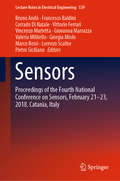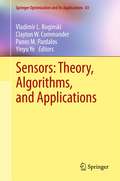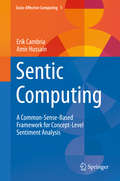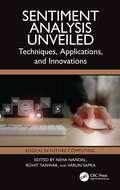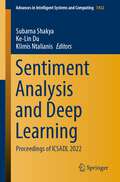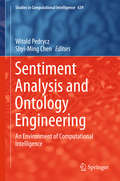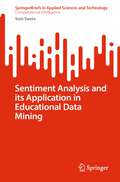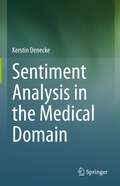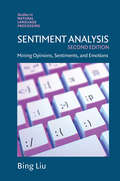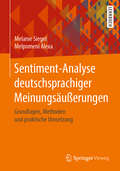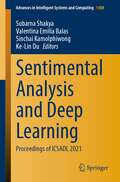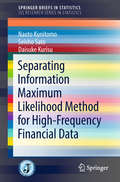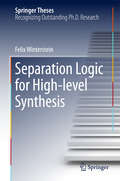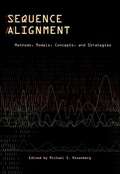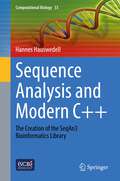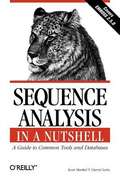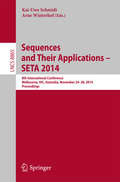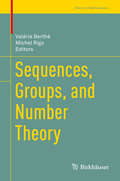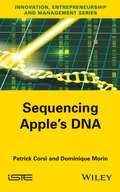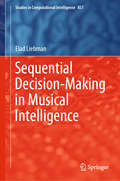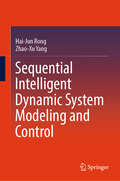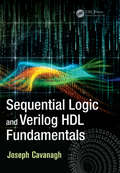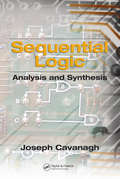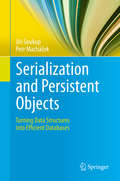- Table View
- List View
Sensors: Proceedings Of The Second National Conference On Sensors, Rome 19-21 February 2014 (Lecture Notes in Electrical Engineering #319)
by Marco Rossi Corrado Di Natale Pietro Siciliano Vittorio Ferrari Bruno Andò Vincenzo Marletta Francesco Baldini Giovanna Marrazza Valeria Militello Giorgia Miolo Lorenzo ScaliseThis book contains a selection of papers presented at the Second National Conference on Sensors held in Rome 19-21 February 2014. The conference highlighted state-of-the-art results from both theoretical and applied research in the field of sensors and related technologies. This book presents material in an interdisciplinary approach, covering many aspects of the disciplines related to sensors, including physics, chemistry, materials science, biology and applications.
Sensors: Theory, Algorithms, and Applications (Springer Optimization and Its Applications #61)
by Panos M. Pardalos Vladimir L. Boginski Yinyu Ye Clayton W. CommanderThe objective of this book is to advance the current knowledge of sensor research particularly highlighting recent advances, current work, and future needs. The goal is to share current technologies and steer future efforts in directions that will benefit the majority of researchers and practitioners working in this broad field of study.
Sentic Computing
by Amir Hussain Erik CambriaIn this book common sense computing techniques are further developed and applied to bridge the semantic gap between word-level natural language data and the concept-level opinions conveyed by these. In particular, the ensemble application of graph mining and multi-dimensionality reduction techniques is exploited on two common sense knowledge bases to develop a novel intelligent engine for open-domain opinion mining and sentiment analysis. The proposed approach, termed sentic computing, performs a clause-level semantic analysis of text, which allows the inference of both the conceptual and emotional information associated with natural language opinions and, hence, a more efficient passage from (unstructured) textual information to (structured) machine-processable data.
Sentiment Analysis
by Bing LiuSentiment analysis and opinion mining is the field of study that analyzes people's opinions, sentiments, evaluations, attitudes, and emotions from written language. It is one of the most active research areas in natural language processing and is also widely studied in data mining, Web mining, and text mining. In fact, this research has spread outside of computer science to the management sciences and social sciences due to its importance to business and society as a whole. The growing importance of sentiment analysis coincides with the growth of social media such as reviews, forum discussions, blogs, micro-blogs, Twitter, and social networks. For the first time in human history, we now have a huge volume of opinionated data recorded in digital form for analysis. Sentiment analysis systems are being applied in almost every business and social domain because opinions are central to almost all human activities and are key influencers of our behaviors. Our beliefs and perceptions of reality, and the choices we make, are largely conditioned on how others see and evaluate the world. For this reason, when we need to make a decision we often seek out the opinions of others. This is true not only for individuals but also for organizations. This book is a comprehensive introductory and survey text. It covers all important topics and the latest developments in the field with over 400 references. It is suitable for students, researchers and practitioners who are interested in social media analysis in general and sentiment analysis in particular. Lecturers can readily use it in class for courses on natural language processing, social media analysis, text mining, and data mining. Lecture slides are also available online. Table of Contents: Preface / Sentiment Analysis: A Fascinating Problem / The Problem of Sentiment Analysis / Document Sentiment Classification / Sentence Subjectivity and Sentiment Classification / Aspect-Based Sentiment Analysis / Sentiment Lexicon Generation / Opinion Summarization / Analysis of Comparative Opinions / Opinion Search and Retrieval / Opinion Spam Detection / Quality of Reviews / Concluding Remarks / Bibliography / Author Biography
Sentiment Analysis Unveiled: Techniques, Applications, and Innovations (Edge AI in Future Computing)
by Rohit Tanwar Varun Sapra Neha NandalThis book is a comprehensive exploration into the realm of sentiment analysis. From deciphering customer sentiments for businesses to understanding public opinions on social media or predicting market trends, the applications are multifaceted and impactful.Sentiment Analysis Unveiled: Techniques, Applications, and Innovations is more than just algorithms and models; it’s about unraveling the emotions, opinions, and perceptions encapsulated within the vast sea of textual data. This book explores topics from opinion mining, social media analysis, deep learning, security concerns, and healthcare systems, and it also delves into the ethical and legal implications of sentiment analysis. Through practical examples, case studies, and discussions on cutting‑edge innovations, the editors aim is to provide a holistic view that empowers you to navigate this field confidently. It involves the analysis of user‑generated content, deciphering sentiments expressed on platforms like Twitter and Facebook, and provides valuable insights into public opinion, brand perception, and emerging trends in the digital landscape.This book is intended for professionals, researchers, and scientists in the field of artificial intelligence and sentiments analysis; it will serve as a valuable resource for both beginners and experienced professionals in the field.
Sentiment Analysis and Deep Learning: Proceedings of ICSADL 2022 (Advances in Intelligent Systems and Computing #1432)
by Ke-Lin Du Klimis Ntalianis Subarna ShakyaThis book gathers selected papers presented at International Conference on Sentimental Analysis and Deep Learning (ICSADL 2022), jointly organized by Tribhuvan University, Nepal and Prince of Songkla University, Thailand during 16 – 17 June, 2022. The volume discusses state-of-the-art research works on incorporating artificial intelligence models like deep learning techniques for intelligent sentiment analysis applications. Emotions and sentiments are emerging as the most important human factors to understand the prominent user-generated semantics and perceptions from the humongous volume of user-generated data. In this scenario, sentiment analysis emerges as a significant breakthrough technology, which can automatically analyze the human emotions in the data-driven applications. Sentiment analysis gains the ability to sense the existing voluminous unstructured data and delivers a real-time analysis to efficiently automate the business processes.
Sentiment Analysis and Ontology Engineering
by Witold Pedrycz Shyi-Ming ChenThis editedvolume provides the reader with a fully updated, in-depth treatise on the emergingprinciples, conceptual underpinnings, algorithms and practice of ComputationalIntelligence in the realization of concepts and implementation of models ofsentiment analysis and ontology -oriented engineering. The volume involves studies devotedto key issues of sentiment analysis, sentiment models, and ontologyengineering. The book is structured into three main parts. The first partoffers a comprehensive and prudently structured exposure to the fundamentals ofsentiment analysis and natural language processing. The second part consists ofstudies devoted to the concepts, methodologies, and algorithmic developmentselaborating on fuzzy linguistic aggregation to emotion analysis, carrying outinterpretability of computational sentiment models, emotion classification,sentiment-oriented information retrieval, a methodology of adaptive dynamics inknowledge acquisition. The third part includes a plethora of applicationsshowing how sentiment analysis and ontologies becomes successfully applied toinvestment strategies, customer experience management, disaster relief,monitoring in social media, customer review rating prediction, and ontologylearning. This book isaimed at a broad audience of researchers and practitioners. Readers involved inintelligent systems, data analysis, Internet engineering, ComputationalIntelligence, and knowledge-based systems will benefit from the exposure to thesubject matter. The book may also serveas a highly useful reference material for graduate students and seniorundergraduate students.
Sentiment Analysis and its Application in Educational Data Mining (SpringerBriefs in Applied Sciences and Technology)
by Soni SwetaThe book delves into the fundamental concepts of sentiment analysis, its techniques, and its practical applications in the context of educational data. The book begins by introducing the concept of sentiment analysis and its relevance in educational settings. It provides a thorough overview of the various techniques used for sentiment analysis, including natural language processing, machine learning, and deep learning algorithms. The subsequent chapters explore applications of sentiment analysis in educational data mining across multiple domains. The book illustrates how sentiment analysis can be employed to analyze student feedback and sentiment patterns, enabling educators to gain valuable insights into student engagement, motivation, and satisfaction. It also examines how sentiment analysis can be used to identify and address students' emotional states, such as stress, boredom, or confusion, leading to more personalized and effective interventions. Furthermore, the book explores the integration of sentiment analysis with other educational data mining techniques, such as clustering, classification, and predictive modeling. It showcases real-world case studies and examples that demonstrate how sentiment analysis can be combined with these approaches to improve educational decision-making, curriculum design, and adaptive learning systems.
Sentiment Analysis in the Medical Domain
by Kerstin DeneckeSentiment analysis deals with extracting information about opinions, sentiments, and even emotions conveyed by writers towards topics of interest. Medical sentiment analysis refers to the identification and analysis of sentiments or emotions expressed in free-textual documents with a scope on healthcare and medicine. This fascinating problem offers numerous application areas in the domain of medicine, but also research challenges. The book provides a comprehensive introduction to the topic. The primary purpose is to provide the necessary background on medical sentiment analysis, ranging from a description of the notions of medical sentiment to use cases that have been considered already and application areas of relevance. Medical sentiment analysis uses natural language processing (NLP), text analysis and machine learning to realise the process of extracting and classifying statements regarding expressed opinion and sentiment. The book offers a comprehensive overview on existing methods of sentiment analysis applied to healthcare resources or health-related documents. It concludes with open research avenues providing researchers indications which topics still have to be developed in more depth.
Sentiment Analysis: Mining Opinions, Sentiments, and Emotions (Studies in Natural Language Processing)
by Bing LiuSentiment analysis is the computational study of people's opinions, sentiments, emotions, moods, and attitudes. This fascinating problem offers numerous research challenges, but promises insight useful to anyone interested in opinion analysis and social media analysis. This comprehensive introduction to the topic takes a natural-language-processing point of view to help readers understand the underlying structure of the problem and the language constructs commonly used to express opinions, sentiments, and emotions. The book covers core areas of sentiment analysis and also includes related topics such as debate analysis, intention mining, and fake-opinion detection. It will be a valuable resource for researchers and practitioners in natural language processing, computer science, management sciences, and the social sciences. In addition to traditional computational methods, this second edition includes recent deep learning methods to analyze and summarize sentiments and opinions, and also new material on emotion and mood analysis techniques, emotion-enhanced dialogues, and multimodal emotion analysis.
Sentiment-Analyse deutschsprachiger Meinungsäußerungen: Grundlagen, Methoden und praktische Umsetzung
by Melanie Siegel Melpomeni AlexaDer Zugang zu Information ist durch das Internet erheblich verändert und erleichtert worden. Gleichzeitig gibt es seit dem Web 2.0 die Möglichkeit für alle Internet-Nutzer, selbst Inhalte beizusteuern, indem sie in Foren schreiben, oder Twitter, Xing, LinkedIn, Facebook oder andere soziale Medien nutzen und auf veröffentliche Posts z. B. durch Kommentare reagieren. Diese Fülle an Informationen und Meinungen ist ein wertvoller und in der Regel sehr großer Datenschatz, den man nur mit automatischen Verfahren sinnvoll nutzen kann.Die automatische Analyse von Meinungsäußerungen gehört in die Anwendungsbereiche Informationsextraktion und Inhaltsanalyse sowie Text Mining. Aus Texten von Internet-Nutzern werden Informationen extrahiert und analysiert, wie sie sich zu bestimmten Themen, Produkten oder Ereignissen äußern.Dieses Buch gibt eine systematische Einführung in Methoden der automatischen Analyse von Meinungsäußerungen und zeigt die Anwendung der beschriebenen Methoden in Programmierübungen. Der Fokus liegt dabei auf deutschsprachige Daten, also auf linguistischen Ressourcen sowie Methoden zur automatischen Analyse für die deutsche Sprache. Viele Übungsaufgaben sowie in Python implementierte Programmierbeispiele und -aufgaben machen das Buch zum optimalen Begleiter für Studium und Selbststudium.
Sentimental Analysis and Deep Learning: Proceedings of ICSADL 2021 (Advances in Intelligent Systems and Computing #1408)
by Ke-Lin Du Valentina Emilia Balas Subarna Shakya Sinchai KamolphiwongThis book gathers selected papers presented at the International Conference on Sentimental Analysis and Deep Learning (ICSADL 2021), jointly organized by Tribhuvan University, Nepal; Prince of Songkla University, Thailand; and Ejesra during June, 18–19, 2021. The volume discusses state-of-the-art research works on incorporating artificial intelligence models like deep learning techniques for intelligent sentiment analysis applications. Emotions and sentiments are emerging as the most important human factors to understand the prominent user-generated semantics and perceptions from the humongous volume of user-generated data. In this scenario, sentiment analysis emerges as a significant breakthrough technology, which can automatically analyze the human emotions in the data-driven applications. Sentiment analysis gains the ability to sense the existing voluminous unstructured data and delivers a real-time analysis to efficiently automate the business processes. Meanwhile, deep learning emerges as the revolutionary paradigm with its extensive data-driven representation learning architectures. This book discusses all theoretical aspects of sentimental analysis, deep learning and related topics.
Separating Information Maximum Likelihood Method for High-Frequency Financial Data (SpringerBriefs in Statistics #0)
by Naoto Kunitomo Seisho Sato Daisuke KurisuThis book presents a systematic explanation of the SIML (Separating Information Maximum Likelihood) method, a new approach to financial econometrics.Considerable interest has been given to the estimation problem of integrated volatility and covariance by using high-frequency financial data. Although several new statistical estimation procedures have been proposed, each method has some desirable properties along with some shortcomings that call for improvement. For estimating integrated volatility, covariance, and the related statistics by using high-frequency financial data, the SIML method has been developed by Kunitomo and Sato to deal with possible micro-market noises.The authors show that the SIML estimator has reasonable finite sample properties as well as asymptotic properties in the standard cases. It is also shown that the SIML estimator has robust properties in the sense that it is consistent and asymptotically normal in the stable convergence sense when there are micro-market noises, micro-market (non-linear) adjustments, and round-off errors with the underlying (continuous time) stochastic process. Simulation results are reported in a systematic way as are some applications of the SIML method to the Nikkei-225 index, derived from the major stock index in Japan and the Japanese financial sector.
Separation Logic for High-level Synthesis
by Felix WintersteinThis book presents novel compiler techniques, which combine a rigorous mathematical framework, novel program analyses and digital hardware design to advance current high-level synthesis tools and extend their scope beyond the industrial 'state of the art'. Implementing computation on customised digital hardware plays an increasingly important role in the quest for energy-efficient high-performance computing. Field-programmable gate arrays (FPGAs) gain efficiency by encoding the computing task into the chip's physical circuitry and are gaining rapidly increasing importance in the processor market, especially after recent announcements of large-scale deployments in the data centre. This is driving, more than ever, the demand for higher design entry abstraction levels, such as the automatic circuit synthesis from high-level languages (high-level synthesis). The techniques in this book apply formal reasoning to high-level synthesis in the context of demonstrably practical applications.
Sequence Alignment: Methods, Models, Concepts, and Strategies
by Michael S. RosenbergThe sequencing of the human genome involved thousands of scientists but used relatively few tools. Today, obtaining sequences is simpler, but aligning the sequences--making sure that sequences from one source are properly compared to those from other sources--remains a complicated but underappreciated aspect of comparative molecular biology.
Sequence Analysis and Modern C++: The Creation of the SeqAn3 Bioinformatics Library (Computational Biology #33)
by Hannes HauswedellThis is a book about software engineering, bioinformatics, the C++ programming language and the SeqAn library. In the broadest sense, it will help the reader create better, faster and more reliable software by deepening their understanding of available tools, language features, techniques and design patterns.Every developer who previously worked with C++ will enjoy the in-depth chapter on important changes in the language from C++11 up to and including C++20. In contrast to many resources on Modern C++ that present new features only in small isolated examples, this book represents a more holistic approach: readers will understand the relevance of new features and how they interact in the context of a large software project and not just within a "toy example". Previous experience in creating software with C++ is highly recommended to fully appreciate these aspects.SeqAn3 is a new, re-designed software library. The conception and implementation process is detailed in this book, including a critical reflection on the previous versions of the library. This is particularly helpful to readers who are about to create a large software project themselves, or who are planning a major overhaul of an existing library or framework. While the focus of the book is clearly on software development and design, it also touches on various organisational and administrative aspects like licensing, dependency management and quality control.
Sequence Analysis in a Nutshell
by Darryl Leon Scott MarkelSequence Analysis in a Nutshell: A Guide to Common Tools and Databasespulls together all of the vital information about the most commonly used databases, analytical tools, and tables used in sequence analysis. The book contains details and examples of the common database formats (GenBank, EMBL, SWISS-PROT) and the GenBank/EMBL/DDBJ Feature Table Definitions. It also provides the command line syntax for popular analysis applications such as Readseq and MEME/MAST, BLAST, ClustalW, and the EMBOSS suite, as wel
Sequences and Their Applications - SETA 2014
by Arne Winterhof Kai-Uwe SchmidtThis book constitutes the refereed proceedings of the 8th International Conference on Sequences and Their Applications, SETA 2014, held in Melbourne, VIC, Australia, in November 2014. The 24 full papers presented together with 2 invited papers were carefully reviewed and selected from 36 submissions. The papers have been organized in topical sections on Boolean functions, perfect sequences, correlation of arrays, relative difference sets, aperiodic correlation, pseudorandom sequences and stream ciphers, crosscorrelation of sequences, prime numbers in sequences, OFDM and CDMA, and frequency-hopping sequences.
Sequences, Groups, and Number Theory
by Valérie Berthé Michel RigoThis collaborative book presents recent trends on the study of sequences, including combinatorics on words and symbolic dynamics, and new interdisciplinary links to group theory and number theory. Other chapters branch out from those areas into subfields of theoretical computer science, such as complexity theory and theory of automata. The book is built around four general themes: number theory and sequences, word combinatorics, normal numbers, and group theory. Those topics are rounded out by investigations into automatic and regular sequences, tilings and theory of computation, discrete dynamical systems, ergodic theory, numeration systems, automaton semigroups, and amenable groups. This volume is intended for use by graduate students or research mathematicians, as well as computer scientists who are working in automata theory and formal language theory. With its organization around unified themes, it would also be appropriate as a supplemental text for graduate level courses.
Sequencing Apple's DNA
by Patrick Corsi Dominique MorinThis book aims to extract the "molecular genes" leading to craziness! Geniuses are the ones who are "crazy enough to think they can change the world" and boldly go where no one has gone before. Where no past habit and usage are available, there is no proof of viability, as nobody has done it yet, or even imagined it, and no roadmap for guidance or market study has come up with it. The authors call upon Leonardo Da Vinci, the Renaissance genius, who as strange as it seems, shared many traits of personality with that of Steve Jobs, in terms of the ways of performing. Da Vinci helps in understanding Jobs, and hence Apple, with his unique way of designing radically novel concepts, which were actually quite crazy for his time. In order to shed light on a special creative posture, the indomitable sense of specifying undecidable objects - a hallmark of the late Steve Jobs - is what led the authors to match it with a specific design innovation theory. A real theory, backed by solid mathematical proof, exists and can account for the business virtue of a prolific ability to move into unknown crazy fields! The authors postulate that, by bringing the power of C-K theory to crack open a number of previous observations made about Apple's methods, it is possible to identify most of the genes of this company. The authors analyze how and why an Apple way of doing business is radically different from standard business practices and why it is so successful. Genes are a measure of the entity at hand and can encourage past business education routine approaches, then become transferable across the spectrum of the socio-economic world.
Sequential Decision-Making in Musical Intelligence (Studies in Computational Intelligence #857)
by Elad LiebmanOver the past 60 years, artificial intelligence has grown from an academic field of research to a ubiquitous array of tools used in everyday technology. Despite its many recent successes, certain meaningful facets of computational intelligence have yet to be thoroughly explored, such as a wide array of complex mental tasks that humans carry out easily, yet are difficult for computers to mimic. A prime example of a domain in which human intelligence thrives, but machine understanding is still fairly limited, is music. Over recent decades, many researchers have used computational tools to perform tasks like genre identification, music summarization, music database querying, and melodic segmentation. While these are all useful algorithmic solutions, we are still a long way from constructing complete music agents able to mimic (at least partially) the complexity with which humans approach music. One key aspect that hasn't been sufficiently studied is that of sequential decision-making in musical intelligence. Addressing this gap, the book focuses on two aspects of musical intelligence: music recommendation and multi-agent interaction in the context of music. Though motivated primarily by music-related tasks, and focusing largely on people's musical preferences, the work presented in this book also establishes that insights from music-specific case studies can also be applicable in other concrete social domains, such as content recommendation.Showing the generality of insights from musical data in other contexts provides evidence for the utility of music domains as testbeds for the development of general artificial intelligence techniques.Ultimately, this thesis demonstrates the overall value of taking a sequential decision-making approach in settings previously unexplored from this perspective.
Sequential Intelligent Dynamic System Modeling and Control
by Hai-Jun Rong Zhao-Xu YangThe book offers novel research results of sequential intelligent dynamic system modeling and control in a unified framework from theory proposals to real applications. It covers an in-depth study of various learning algorithms for the permanent adaptation of intelligent model parameters as well as of structural parts of the model. The comprehensive researches on sequential fuzzy and neural controller design schemes for some complex real applications are included. This is particularly suited for readers who are interested to learn practical solutions for controlling nonlinear systems that are uncertain and varied at any time. In addition, the organization of the book from addressing fundamental concepts, and presenting novel intelligent models to solving real applications is one of the major features of the book, which makes it a valuable resource for both beginners and researchers wanting to further their understanding and study about realtime online intelligent modeling and control ofnonlinear dynamic systems. The book can benefit researchers, engineers, and graduate students in the fields of control engineering, artificial intelligence, computational intelligence, intelligent control, nonlinear system modeling, and control, etc.
Sequential Logic and Verilog HDL Fundamentals
by Joseph CavanaghSequential Logic and Verilog HDL Fundamentals discusses the analysis and synthesis of synchronous and asynchronous sequential machines. These machines are implemented using Verilog Hardware Description Language (HDL), in accordance with the Institute of Electrical and Electronics Engineers (IEEE) Standard: 1364-1995. The book concentrates on sequential logic design with a focus on the design of various Verilog HDL projects. Emphasis is placed on structured and rigorous design principles that can be applied to practical applications. Each step of the analysis and synthesis procedures is clearly delineated. Each method that is presented is expounded in sufficient detail with accompanying examples. Many analysis and synthesis examples use mixed-logic symbols incorporating both positive- and negative-input logic gates for NAND (not AND) and NOR (not OR) logic, while other examples utilize only positive-input logic gates. The use of mixed logic parallels the use of these symbols in the industry. The book is intended to be a tutorial, and as such, is comprehensive and self-contained. All designs are carried through to completion—nothing is left unfinished or partially designed. Each chapter contains numerous problems of varying complexity to be designed by the reader using Verilog HDL design techniques. The Verilog HDL designs include the design module, the test bench module that tests the design for correct functionality, the outputs obtained from the test bench, and the waveforms obtained from the test bench. Sequential Logic and Verilog HDL Fundamentals presents Verilog HDL with numerous design examples to help the reader thoroughly understand this popular hardware description language. The book is designed for practicing electrical engineers, computer engineers, and computer scientists; for graduate students in electrical engineering, computer engineering, and computer science; and for senior-level undergraduate students.
Sequential Logic: Analysis and Synthesis
by Joseph CavanaghUntil now, there was no single resource for actual digital system design. Using both basic and advanced concepts, Sequential Logic: Analysis and Synthesis offers a thorough exposition of the analysis and synthesis of both synchronous and asynchronous sequential machines. With 25 years of experience in designing computing equipment, the author stresses the practical design of state machines. He clearly delineates each step of the structured and rigorous design principles that can be applied to practical applications. The book begins by reviewing the analysis of combinatorial logic and Boolean algebra, and goes on to define sequential machines and discuss traditional and alternative methods for synthesizing synchronous sequential machines. The final chapters deal with asynchronous sequential machines and pulse-mode asynchronous sequential machines. Because this volume is technology-independent, these techniques can be used in a variety of fields, such as electrical and computer engineering as well as nanotechnology.By presenting each method in detail, expounding on several corresponding examples, and providing over 500 useful figures, Sequential Logic is an excellent tutorial on analysis and synthesis procedures.
Serialization and Persistent Objects
by Jiri Soukup Petr MacháčekRecently, the pressure for fast processing and efficient storage of large data with complex relations increased beyond the capability of traditional databases. Typical examples include iPhone applications, computer aided design - both electrical and mechanical, biochemistry applications, and incremental compilers. Serialization, which is sometimes used in such situations is notoriously tedious and error prone. In this book, Jiri Soukup and Petr MacháÄ ek show in detail how to write programs which store their internal data automatically and transparently to disk. Together with special data structure libraries which treat relations among objects as first-class entities, and with a UML class-diagram generator, the core application code is much simplified. The benchmark chapter shows a typical example where persistent data is faster by the order of magnitude than with a traditional database, in both traversing and accessing the data. The authors explore and exploit advanced features of object-oriented languages in a depth hardly seen in print before. Yet, you as a reader need only a basic knowledge of C++, Java, C#, or Objective C. These languages are quite similar with respect to persistency, and the authors explain their differences where necessary. The book targets professional programmers working on any industry applications, it teaches you how to design your own persistent data or how to use the existing packages efficiently. Researchers in areas like language design, compiler construction, performance evaluation, and no-SQL applications will find a wealth of novel ideas and valuable implementation tips. Under http://www. codefarms. com/book, you will find a blog and other information, including a downloadable zip file with the sources of all the listings that are longer than just a few lines - ready to compile and run.
